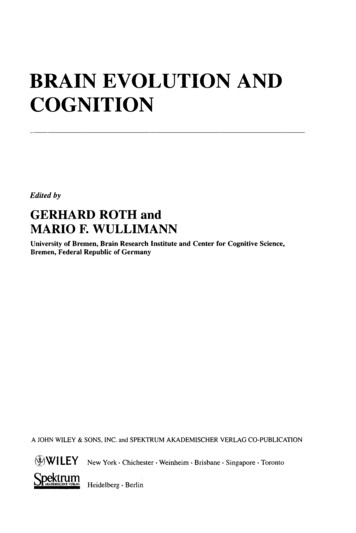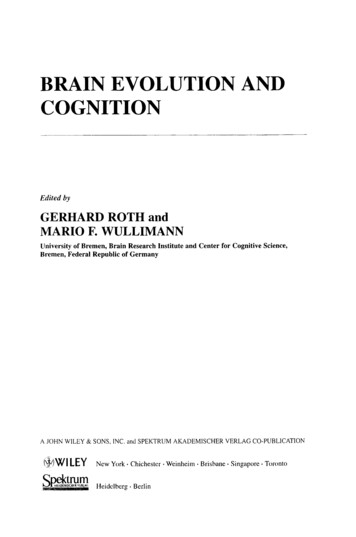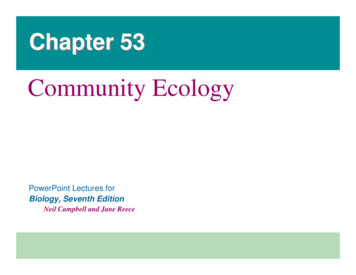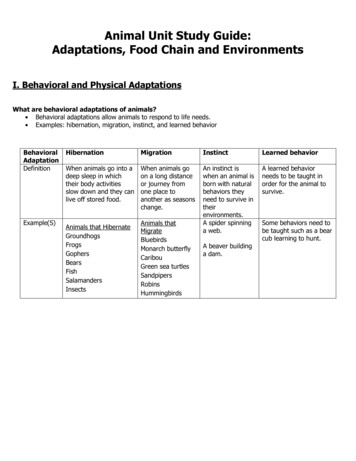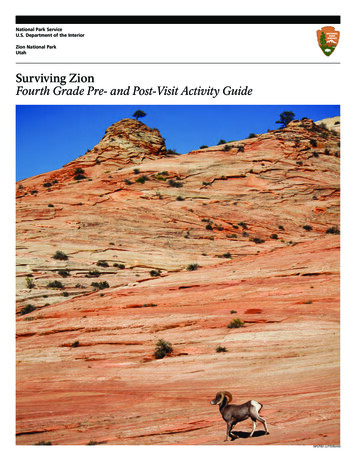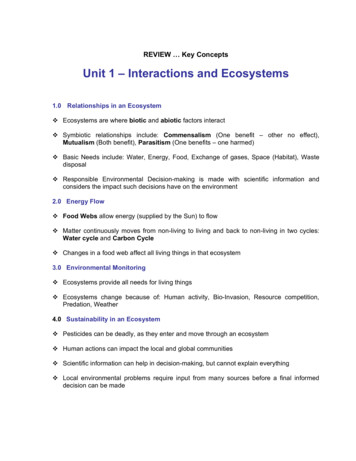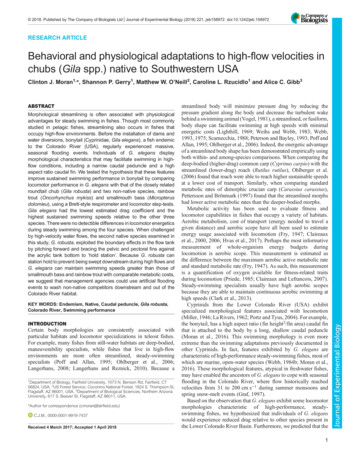
Transcription
2018. Published by The Company of Biologists Ltd Journal of Experimental Biology (2018) 221, jeb158972. doi:10.1242/jeb.158972RESEARCH ARTICLEBehavioral and physiological adaptations to high-flow velocities inchubs (Gila spp.) native to Southwestern USAABSTRACTMorphological streamlining is often associated with physiologicaladvantages for steady swimming in fishes. Though most commonlystudied in pelagic fishes, streamlining also occurs in fishes thatoccupy high-flow environments. Before the installation of dams andwater diversions, bonytail (Cyprinidae, Gila elegans), a fish endemicto the Colorado River (USA), regularly experienced massive,seasonal flooding events. Individuals of G. elegans displaymorphological characteristics that may facilitate swimming in highflow conditions, including a narrow caudal peduncle and a highaspect ratio caudal fin. We tested the hypothesis that these featuresimprove sustained swimming performance in bonytail by comparinglocomotor performance in G. elegans with that of the closely relatedroundtail chub (Gila robusta) and two non-native species, rainbowtrout (Oncorhynchus mykiss) and smallmouth bass (Micropterusdolomieu), using a Brett-style respirometer and locomotor step-tests.Gila elegans had the lowest estimated drag coefficient and thehighest sustained swimming speeds relative to the other threespecies. There were no detectible differences in locomotor energeticsduring steady swimming among the four species. When challengedby high-velocity water flows, the second native species examined inthis study, G. robusta, exploited the boundary effects in the flow tankby pitching forward and bracing the pelvic and pectoral fins againstthe acrylic tank bottom to ‘hold station’. Because G. robusta canstation hold to prevent being swept downstream during high flows andG. elegans can maintain swimming speeds greater than those ofsmallmouth bass and rainbow trout with comparable metabolic costs,we suggest that management agencies could use artificial floodingevents to wash non-native competitors downstream and out of theColorado River habitat.KEY WORDS: Endemism, Native, Caudal peduncle, Gila robusta,Colorado River, Swimming performanceINTRODUCTIONCertain body morphologies are consistently associated withparticular habitats and locomotor specializations in teleost fishes.For example, many fishes from still-water habitats are deep-bodied,maneuverability specialists, while fishes that live in high-flowenvironments are more often streamlined, steady-swimmingspecialists (Poff and Allan, 1995; Ohlberger et al., 2006;Langerhans, 2008; Langerhans and Reznick, 2010). Because a1Department of Biology, Fairfield University, 1073 N. Benson Rd, Fairfield, CT06824, USA. 2US Forest Service, Coconino National Forest, 1824 S. Thompson St,Flagstaff, AZ 86001, USA. 3Department of Biological Sciences, Northern ArizonaUniversity, 617 S. Beaver St, Flagstaff, AZ 86011, USA.*Author for correspondence (cmoran@fairfield.edu)C.J.M., 0000-0001-9919-7437Received 4 March 2017; Accepted 1 April 2018streamlined body will minimize pressure drag by reducing thepressure gradient along the body and decrease the turbulent wakebehind a swimming animal (Vogel, 1981), a streamlined, or fusiform,body shape can facilitate swimming at high speeds with minimalenergetic costs (Lighthill, 1969; Weihs and Webb, 1983; Webb,1993, 1975; Scarnecchia, 1988; Peterson and Bayley, 1993; Poff andAllan, 1995; Ohlberger et al., 2006). Indeed, the energetic advantageof a streamlined body shape has been demonstrated empirically usingboth within- and among-species comparisons. When comparing thedeep-bodied (higher-drag) common carp (Cyprinus carpio) with thestreamlined (lower-drag) roach (Rutilus rutilus), Ohlberger et al.(2006) found that roach were able to reach higher sustainable speedsat a lower cost of transport. Similarly, when comparing standardmetabolic rates of dimorphic crucian carp (Carassius carassius),Pettersson and Brönmark (1997) found that the streamlined morphshad lower active metabolic rates than the deeper-bodied morphs.Metabolic activity has been used to evaluate fitness andlocomotor capabilities in fishes that occupy a variety of habitats.Aerobic metabolism, cost of transport (energy needed to travel agiven distance) and aerobic scope have all been used to estimateenergy usage associated with locomotion (Fry, 1947; Claireauxet al., 2000, 2006; Hvas et al., 2017). Perhaps the most informativemeasurement of whole-organism energy budgets duringlocomotion is aerobic scope. This measurement is estimated asthe difference between the maximum aerobic active metabolic rateand standard metabolic rate (Fry, 1947). As such, this measurementis a quantification of oxygen available for fitness-related traitsduring locomotion (Priede, 1985; Claireaux and Lefrancois, 2007).Steady-swimming specialists usually have high aerobic scopesbecause they are able to maintain continuous aerobic swimming athigh speeds (Clark et al., 2013).Cyprinids from the Lower Colorado River (USA) exhibitspecialized morphological features associated with locomotion(Miller, 1946; La Rivers, 1962; Portz and Tyus, 2004). For example,the bonytail, has a high aspect ratio (fin height2/fin area) caudal finthat is attached to the body by a long, shallow caudal peduncle(Moran et al., 2016). This swimming morphology is even moreextreme than the swimming adaptations previously documented inother Cyprinids. In fact, features exhibited by G. elegans arecharacteristic of high-performance steady-swimming fishes, most ofwhich are marine, open-water species (Webb, 1984b; Moran et al.,2016). These morphological features, atypical in freshwater fishes,may have enabled the ancestors of G. elegans to cope with seasonalflooding in the Colorado River, where flow historically reachedvelocities from 31 to 200 cm s 1 during summer monsoons andspring snow-melt events (Graf, 1997).Based on the observation that G. elegans exhibit some locomotormorphologies characteristic of high-performance, steadyswimming fishes, we hypothesized that individuals of G. eleganswould experience reduced drag relative to other species present inthe Lower Colorado River Basin. Furthermore, we predicted that the1Journal of Experimental BiologyClinton J. Moran1,*, Shannon P. Gerry1, Matthew W. O’Neill2, Caroline L. Rzucidlo1 and Alice C. Gibb3
RESEARCH ARTICLEJournal of Experimental Biology (2018) 221, jeb158972. doi:10.1242/jeb.158972streamlined body, in combination with a shallow caudal peduncleand a high aspect ratio tail, would allow individuals of G. elegans tomaintain high swimming speeds – speeds that enabled theirancestors to maintain position in the Colorado River duringhistoric flooding events. To assess the swimming performance ofG. elegans relative to that of other native and non-native fish speciesof the Colorado River, we compared swimming behavior andperformance in G. elegans with that of a close relative that lives insmaller tributaries of the Colorado River, the roundtail chub (Gilarobusta), and two non-native fishes that have been introduced to theLower Colorado River basin within the last 100 years, smallmouthbass (Centrarchidae, Micropterus dolomieu) and rainbow trout(Salmonidae, Oncorhynchus mykiss). We measured the maximumsustainable swimming speed and oxygen consumption of these fourspecies to test our prediction that axial and tail morphology of G.elegans enable individuals of this species to maintain high speedswith low metabolic cost (i.e. a lower cost of transport), relative toanother native cyprinid and to two introduced non-native fishes.MATERIALS AND METHODSFish specimensGila robusta S. F. Baird & Girard 1853 and Gila elegans S. F. Baird& Girard 1853 were hatchery raised at the Aquatic Research andConservation Center (ARCC) in Cornville, AZ, USA (ArizonaGame and Fish Department, AGFD). Oncorhynchus mykiss(Walbaum 1792) were collected from hatchery-raised stocks inthe Page Springs Trout Hatchery in Cornville, AZ, USA (AGFD).Specimens of Micropterus dolomieu Lacépède 1802 were capturedby electro-fishing from Clear Creek, AZ, USA. All fishes (5 of eachspecies) were size matched (13.0–16.2 cm standard length; Table 1)and held at ARCC; these holding tanks were maintained attemperatures of 20 1 C. Fishes were fed earthworm flake food(Brine Shrimp Direct, Ogden, UT, USA) once every other day; foodwas withheld 48 h prior to a swimming trial to reduce the effects ofspecific dynamic action on metabolic rate. All specimens werecaptured and maintained according to AGFD protocols.Morphologyprediction that G. elegans have a more streamlined body shapethan the other species tested here (Webb, 1975; Fish, 1996).Following Pettersson and Brönmark (1997), we captured stillimages from video taken of fish swimming at 1.5 body lengths s 1(LB s 1) during respirometry experiments. Images were scaled tofish length and analyzed using ImageJ (NIH; Abràmoff et al., 2004).From five individuals per species, fish mass, total length, greatestdorsoventral depth, greatest lateral width, fineness ratio (totallength/greatest depth), least caudal peduncle depth (dorsoventraldepth of the caudal peduncle at the narrowest segment) and dragcoefficient were measured and calculated (Table 1). Fineness ratio isa metric commonly used to estimate streamlining, but ratios canvary from 3 to 7 with only a 10% increase in drag (Webb, 1975).Therefore, we also calculated theoretical drag coefficients to betterassess the hydrodynamic effects of streamlining because increaseddrag, the opposing force to forward thrust during swimming, wouldbe a hydrodynamic disadvantage in steady-swimming fishes(Webb, 1975; Pettersson and Brönmark, 1997). To make thiscalculation, we measured the surface area of one side of the fishfrom a photo of the lateral aspect of the fish, excluding the paired,dorsal and anal fins (fins were excluded from the lateral surface areabecause their shapes were variable within and among speeds). Totalsurface area was calculated as twice the lateral surface area asmeasured from the photo. Dorsal and ventral surface area were notmeasured, equating to an underestimate of wetted surface area;however, this technique was used across all species, which provideda consistent approximation of wetted surface area. Assuming a rigidbody, theoretical drag D at a given speed was calculated using theequation:D ¼ 1 2r S U 2 CT ;ð1Þ 3where ρ is the density of water (1.0 g cm ), S is the estimated lateralsurface area of the fish, U is the velocity and CT is the dragcoefficient (Webb, 1975). CT is composed of the frictional dragcoefficient Cf and the pressure drag coefficient Cp. Because we wereinterested in the differences in body shape, velocity was 1.0 for alldrag coefficient calculations. CT was calculated using the equation:Fineness ratios, theoretical drag coefficients and least caudalpeduncle depths were measured and calculated to test theCT ¼ Cf ½1 þ 1:5ðd LÞ3 2 þ 7ðd LÞ3 :ð2ÞTable 1. Morphology and habitat of the fishes used in this studyIllustrationTotallength (cm)Mass(g)Width(cm)Depth(cm)Peduncledepth (cm)FinenessratioDragcoefficientJournal of Experimental BiologySpeciesGila elegansGila robustaOncorhynchusmykissMicropterusdolomieuData are means s.e.m. Lowercase letters indicate statistical significance (P 0.05) for examined variables.2
RESEARCH ARTICLEJournal of Experimental Biology (2018) 221, jeb158972. doi:10.1242/jeb.158972The term d is the mean value of maximum width and maximumdepth of the fish body and L is the total length of the body. Cf isdependent on the flow regime, which is characterized by theReynolds number Re, and varies between 1.33Re 0.5 and0.072Re 0.2 for turbulent and laminar flow, respectively. Wechose an arbitrary intermediate value to describe Cf:Cf ¼ 0:74 Re 0:3 ;ð3Þwhere the Reynolds number is a function of the length (L), velocity(U) and the kinematic viscosity of water (ν, 1.2 10 2 s 1 cm2)(Webb, 1975):Re ¼ ðL U Þ n:was calculated as mg O2 kg 1 h 1. Umax was defined as the highestspeed at which the fish was able to continuously swim withoutresorting to the burst-and-glide mode of locomotion (Rome, 1995).COTNet was calculated from the slope of the linear regression ofmass-specific metabolic rate and swimming speed in m h 1 (mgO2 kg 1 m 1) (Bennett, 1985; Sepulveda and Dickson, 2000).Individual slope units were converted to J kg 1 m 1 by multiplyingby the oxycalorific constant of 13.54 J mg 1 O2. The y-intercept forthe regression lines of metabolic rate and speed was used as anestimate of SMR (Fry and Hochachka, 1970; Sepulveda andDickson, 2000). Aerobic scope was calculated as the differencebetween maximum aerobic metabolic rate and SMR.ð4ÞBehavior and kinematicsUsing a Brett-type swimming tunnel respirometer (a closed-system,recirculating flow tunnel with an oxygen electrode), the rate ofoxygen consumption (V̇ O2) was measured during swimming steptests using methods similar to classic studies by Videler (1993) andRome (1995). The working space for the swim tunnel was13.5 13.5 50.8 cm. The cross-sectional area of the largest fishused in this study was 10% of the cross-sectional area of thechamber, so potential blocking effects were not considered (Brett,1964; Webb, 1971). This tunnel continuously recirculated a totalvolume of 35 l and the velocity of the water was controlled by avariable-speed pump that drove a propeller. Before the trials wereconducted, a flow meter (Marsh McBirney Model 2000, Loveland,CO, USA) was placed in the center of the working space to enable usto calibrate flow speed relative to motor speed.Prior to each step-test, the respirometer was opened and flushedwith oxygenated water to restore oxygen levels to 7.0 0.3 mg l 1.Following the flushing period, the tunnel was closed so thatmetabolic rate of oxygen consumption (Ṁ O2) could be measured.During the trials, water oxygen concentration (mg l 1) wasmeasured continuously with a YSI 55 oxygen probe (YellowSprings, OH, USA). Assuming the average density of fish is equal tothat of water, the mass-specific Ṁ O2 at each speed was calculatedusing the equation:M O2 ¼ R½ðVf lume Vf ish Þ M ;ð5Þwhere R is the change in water oxygen concentration over time,Vflume is the flume volume in liters, Vfish is the volume displaced bythe fish and M is the body mass of the fish (Kendall et al., 2007).Five individuals of each species were used in the swimming steptests. Each fish acclimated to the flow tunnel while swimming at aspeed of 1.0 LB s 1 for 30 min. After 30 min, step-tests began atincrements of 0.5 LB s 1. Swimming speed intervals lasted 15 min,during which Ṁ O2 measurements were recorded from the middle10 min of the session. Temperature was maintained at 20 1 Cduring swimming trials. Step-tests continued until continuousswimming was no longer maintained, following methods outlinedin Sepulveda and Dickson (2000). The speed at which fish could nolonger maintain a steady swimming behavior (Umax), resorting to aburst-and-glide gait, suggests that this is the point at which fishbegin to recruit anaerobic muscle fibers (Videler, 1993; Rome,1995).To test the hypothesis that G. elegans is able to swim faster withless metabolic output than the other species tested here, wemeasured metabolic rate and maximum sustainable swimmingspeed (Umax) and made estimates of net cost of transport (COTNet),standard metabolic rate (SMR) and aerobic scope. Metabolic rateHigh-speed video recorded at 600 frames s 1 was analyzed to testthe hypothesis that swimming kinematics are different among thefour species examined here. Orientation angle [angle of the bodyrelative to horizontal (0 deg)], tail beat amplitude (distance thecaudal fin moved during one tail beat), tail beat frequency (numberof tail beats per second) and yaw (lateral displacement of the head)were measured for every speed during sustained swimming. UsingImageJ, all linear measurements taken during the trials were scaledto fish length to generate size-independent performance parameters(e.g. tail beat frequency in L s 1). Measurements of fin and headmovements were made for five complete fin beat cycles andaveraged for a given speed.Statistical analysisPrior to statistical analyses, the data collected during the swimmingtrials were examined for outliers and violations of the assumptionsof ANOVA. Log-transformed data were used for the analysis ofmetabolic rate, tail beat amplitude and yaw because log-transformeddata for these variables fitted the assumptions of normality andhomogeneity of variances, while untransformed data did not. Thestatistical alpha level was 0.05 in all tests and SPSS (v. 21) was usedto conduct all statistical analyses. Raw data are available from thecorresponding author on request.One-way ANOVAs were used to compare morphologicalvariables, Umax and COTNet among species. Mixed-modelANOVAs were used to evaluate metabolic rate, tail beat amplitude,tail beat frequency, yaw and orientation angle for potential maineffects of speed and species, as well as the potential interactionbetween speed and species. A balanced design is required for thisanalysis, so only data for the first four speed intervals were analyzedin the ANOVAs. Under circumstances where the assumption ofsphericity (as determined by Mauchly’s test of sphericity) wasviolated, Greenhouse–Geisser results were used to determinesignificance. Following a significant ANOVA result, LSD post hoctests were conducted to determine which speeds or species weredifferent from one another, as appropriate.RESULTSMorphologyBody fineness ratio differed among the species tested here. Gilarobusta had the greatest fineness ratio (P 0.05) followed byG. elegans (P 0.05). Fineness ratios between O. mykiss andM. dolomieu did not differ. Theoretical hydrodynamic drag differedamong the species tested here; G. elegans had the lowest dragcoefficient (P 0.05) but values were not different among the otherthree species. Least caudal peduncle depth differed among allspecies, with G. elegans having the narrowest peduncle andM. dolomieu having the deepest peduncle (Table 2).3Journal of Experimental BiologyRespirometry
RESEARCH ARTICLEJournal of Experimental Biology (2018) 221, jeb158972. doi:10.1242/jeb.158972Table 2. ANOVA statistics for morphological, kinematic and metabolic data with accompanying least significant difference (LSD) post hoc analysesModelDependent variabled.f.F-statisticP-valueLSDFineness ratioDragPeduncle depthCOTNetSMRUmaxAerobic .2880.38628.3183.265 0.0010.0045 0.0010.8330.765 0.001 0.05e r m de r m de r m d3,163,482.00633.7310.154 0.0011 2 3 43,164,4823.1436.154 0.0010.001e d r m2 3 1(1 4)8.9159.1420.0010.001d (e r) m1 2 3 43,163,489.480.631 0.0010.0050.60625.8743.1371 2 3 4*3,163,488.02613.9670.002 0.001d e r m1 2 3 4One-way ANOVAe m d re dMixed-model ANOVAMetabolic rateSpeciesSpeedOrientation angleSpeciesSpeedTail beat amplitudeSpeciesSpeedTail beat frequencySpeciesSpeedSpecies pecific metabolic rate (mg O2 kg–1 h–1)There was no significant interaction between speed and species andno main effect for species when considering the log of metabolicrate during steady swimming (mixed-model ANOVA). However,there was a significant main effect of speed. Metabolic rate of allfour species consistently increased with increasing swimming speed(Table 2, Fig. 1, Table 3). COTNet and estimates of SMR did not700600500400300G. elegansG. robusta200O. mykiss10000.2M. dolomieu0.30.40.50.6Speed (m s-1)0.7differ among species; however, G. elegans had a higher aerobicscope than M. dolomieu (Table 2, Fig. 2).All species voluntarily swam in the center of the working area ofthe flow tank and did not gravitate toward the bottom or sides of theflow tank, with one exception: G. robusta at the highest speedinterval. At the highest flow speeds ( 2.5 LB s 1), G. robustaindividuals would flatten their paired fins on the bottom of the swimtunnel. Once their pectoral and pelvic fins were positioned againstthe bottom of the swim tunnel, fish would re-orient their bodies toan angle of 20–30 deg relative to the bottom of the flow tunnel.This station-holding behavior was associated with a decrease inmetabolic rate for G. robusta (Fig. 3).Wild fish have been shown to perform better at higher speedsrelative to hatchery-reared fish in some previous studies (e.g.McDonald et al., 1998); therefore, one potentially confoundingvariable in our study was the fact that we used three hatchery-raisedfish species and one wild-caught species. However, the wild-caughtM. dolomieu sustained comparable swimming speeds with similarmetabolic rates to those of some of the hatchery-raised fish. Thissuggests that the one wild-caught species included in this study didnot have a performance or metabolic advantage over the threespecies of hatchery-reared fish.0.8Fig. 1. Metabolic rate of the study species. Metabolic rate increased withincreasing speed but there were no differences among species. The mixedmodel ANOVA was conducted on log-transformed data for the first four speedintervals. Black symbols and lines denote native fish species (Gila elegans andGila robusta) while gray symbols and lines denote non-native fish species(Oncorhynchus mykiss and Micropterus dolomieu). Squares representmainstem Colorado River fishes while triangles represent fishes from ColoradoRiver tributaries. No significant differences among species were detected;however, metabolic rate increased significantly with speed (P 0.01) (n 5/species). Data are means s.e.m. Regression statistics are listed in Table 3.Table 3. Equations and associated error measurements for regressionlines in Fig. 1SpeciesRegression equationSlopes.e.m.y-intercepts.e.m.G. elegansG. robustaO. mykissM. dolomieuy 6.116x 95.338y 5.926x 193.643*y 5.678x 135.607y 4.639x 5R2P-value0.99 0.0010.99 0.0150.97 0.0010.96 0.006*Regression line did not include the last data point for G. robusta on Fig. 1.4Journal of Experimental Biologye, G. elegans; r, Gila robusta; m, O. mykiss; d, M. dolomieu. COTNet, net cost of transport; SMR, standard metabolic rate; Umax, maximum sustainable swimmingspeed.*Interaction term comparisons: G. robusta: 1 2, 1 3 4, 2 4; O. mykiss: 1 2 3, 1 2 4; M. dolomieu: 1 2 3 4.
RESEARCH ARTICLEJournal of Experimental Biology (2018) 221, jeb158972. doi:10.1242/jeb.158972COTNet (J kg–1 m–1)0.03A0.0250.020.0150.010.005Estimated SMR (mg O2 kg–1 h–1)0300B250200150100500Aerobic scope (mg O2 kg–1 h–1)450Ca,ba400a,b350b300250200150100500G. robustaO. mykissM. dolomieuFig. 2. Net cost of transport (COTNet), standard metabolic rate (SMR) and aerobic scope of the studied species. All species had the same COTNet (A) andestimated SMR (B); however, aerobic scope (C) was greater in G. elegans than in M. dolomieu (P 0.05). Black bars denote native fish species while gray barsdenote non-native fish species. Data are means s.e.m. (n 5/species). Significant ANOVA results are denoted by lowercase letters and summarized in Table 2.KinematicsMaximum sustainable swimming speeds (Umax) differed amongall four species considered here (Table 2, Fig. 4). There was nosignificant speed species interaction term when consideringorientation angle during steady swimming (mixed-modelANOVA); however, there were significant speed and species maineffects. A post hoc test revealed that speed one and speed four werestatistically different from one another; high positive orientationangles were more common at speed one, whereas orientation anglesapproaching zero (0 deg) were more common at speed four. Post hocanalysis of the main species suggests that G. robusta and O. mykissconsistently used greater (more positive) orientation angles relativeto G. elegans and M. dolomieu, which had orientation angles closerto zero (Fig. 5A).There was no significant speed species interaction term whenconsidering tail beat amplitude and yaw during steady swimming(mixed-model ANOVA). These kinematic variables demonstratedsignificant speed effects and increased with increasing swimmingspeed. Species and speed main effects were detected for bothamplitude and yaw, with both measurements increasing with5Journal of Experimental BiologyG. elegans
Mass-specific metabolic rate (mg O2 kg–1 h–1)RESEARCH ARTICLEJournal of Experimental Biology (2018) 221, jeb158972. doi:10.1242/jeb.158972700600500400G. elegansFig. 3. Orientation angle. Gila robusta change orientationangle when flow velocity exceeds 0.4 m s 1 (2.5 Lb s 1, whereLb is body lengths). As a result, metabolic rate depressionoccurs at this speed. For comparison, the closely related G.elegans is included, which does not change its orientation angleduring swimming. In addition to changing the orientation angle,G. robusta also uses the pectoral fins and pelvic fins to contactthe bottom of the flow chamber and station hold. Data aremeans s.e.m. (n 5/species).G. robusta30020010000.20.30.40.50.60.70.8Swimming speed (m s-1)DISCUSSIONMaximum sustainable swimming speed (m s–1)Gila elegans, a native Colorado River (USA) species, was able tosustain the highest maximum swimming speed (Umax) relative to theother three species examined in this study. Given the differences insustained swimming performance and the overall similarities acrossspecies in swimming movements (kinematics) and physiology(respiration), how are G. elegans able to reach higher sustainableswimming speeds using similar amounts of energy? Differences inswimming ability may be attributed to the unusual morphologyof G. elegans. A previous study (Moran et al., 2016) reportedthat G. elegans has morphological features similar to those ofhigh-performance swimmers from the marine environment. Ashallow caudal peduncle, high body fineness ratio (approaching theoptimal value of 4.5; Von Mises, 1945), low theoretical drag and ahigh aspect ratio caudal fin are features also exhibited by tunas,many shark species, cetaceans and even extinct swimming reptiles –all of these organisms are thought to be specialized for highperformance, sustained swimming (Webb, 1984a,b; Webb et al.,1984; Pettersson and Hedenström, 2000; Chapman et al., 2015;Baktoft et al., 2016). Additionally, the higher aerobic scopeobserved in G. elegans may allow this species to maintain higheraerobic swimming speeds than the other species tested here. Gilaelegans tended to have a greater aerobic capacity than the closelyrelated G. robusta and the introduced salmonid O. mykiss, althoughthe difference was only significant for M. dolomieu. Aerobic scopecan be an indication of the ability of an organism to cope with agiven environment (Fry, 1947; Hvas et al., 2017). Not surprisingly,of the fishes sampled here, aerobic scope was greatest in those thatcan be found in the mainstem Colorado River, which requires a highcapacity for aerobic steady swimming.It appears that G. elegans locomotor behaviors and morphologiesare modifications for life in the complex habitats of the LowerFig. 4. Maximum sustainable swimming speed (Umax).Gila elegans had the highest Umax while the native G.robusta had the lowest Umax of the species tested here.There was a significant difference among all species(ANOVA, P 0.05, n 5/species). Black bars denote nativespecies while gray bars denote non-native species. Dataare means s.e.m. Statistics are summarized in Table 2.0.80.70.60.50.40.30.20.10G. elegansG. robustaO. mykissM. dolomieu6Journal of Experimental Biologyincreasing speed. Generally, M. dolomieu had the smallest averagetail beat amplitude and yaw while O. mykiss had the greatest tail beatamplitude and yaw (Table 2, Fig. 5B,D). A significant interactionterm was detected for tail beat frequency with a significantspeed effect and a non-significant species effect. The significantinteraction term was created by the unchanging fin beat frequencyof G. elegans over the tested speeds and the increasing finbeat frequency for the other three species tested here (Table 2,Fig. 5C).
Orientation angle(Δ from horizontal, deg)RESEARCH ARTICLE10Journal of Experimental Biology (2018) 221, jeb158972. doi:10.1242/jeb.158972AFig. 5. Swimming kinematics. Swimming kinematicsvaried among species across speeds. (A) Change inorientation angle relative to horizontal (0 deg) acrosssteady swimming speeds. (B) Tail beat displacementduring one beat of the tail across steady swimming speeds.Statistics for tail beat amplitude were conducted on logtransformed data. (C) Frequency of the tail beat acrosssteady swimming speeds. (D) Yaw (lateral displacement ofthe head during one tail beat) across steady swimmingspeeds. Statistics for yaw were conducted on logtransformed data. Black symbols denote native fishspecies while gray symbols denote non-native fishspecies. Squares represent mainstem Colorado Riverfishes while triangles represent fishes from Colorado Rivertributaries. Data are means s.e.m. (n 5/species). ANOVAstatistics are summarized in Table 2.86420–2–4Tail beat amplitude (m)0.04B0.0350.030.0250.02G. elegans0.015G. robusta0.01O. mykiss0.005M. dolomieu0Tail beat frequency (Hz)7C65432100.08DYaw (m)0.060.0400.20.30.40.50.60.70.8Swimming speed (m s-1)Colorado River. Previous work documented similarities inlocomotor morphologies between G. elegans and a highperformance swimmer from the marine environment, Scomberjaponicus (Moran et al., 2016). When our data are compared withthose for similarly sized S. japonicus reported by Donley andDickson (2000), G. elegans has similar tail beat frequencies andamplitudes at matching swimming speeds. This result supports thefindings of Bejan and Marden (2006), who documented afundamental size dependence of kinematic variables duringlocomotion for flying, swimming and walking animals. However,despite similarities in tail movements, the role of the anterior bodycan vary among swimming fishes of different species. This becomesevident when waveforms on the body are measured for a swimmingfish.
Behavioral and physiological adaptationsto high-flow velocities in chubs (Gila spp.) native to Southwestern USA . extreme than the swimming adaptations previously documented in other Cyprinids. In fact, features exhibited by G. elegans are . 617 S. Beaver St, Flagstaff, AZ 86011, USA. *Author for correspondence (cmoran@fairfield.edu) .
